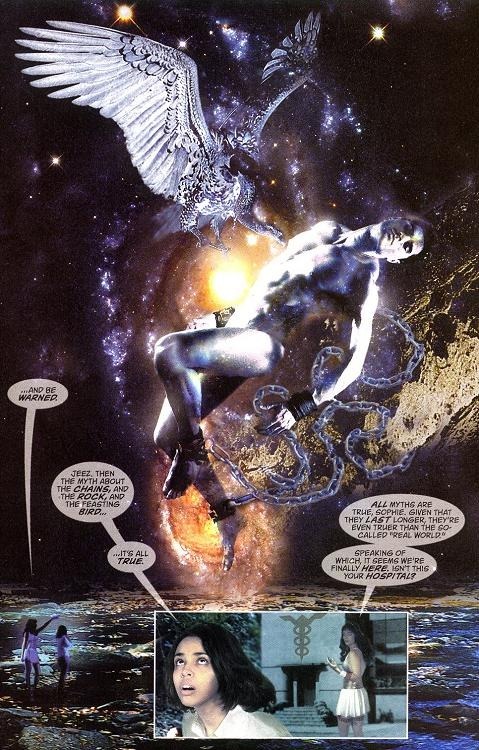WOKE WOMEN AGAINST THE WEST
BY JASON REZA JORJANI, PHD
In Prometheus Bound, Aeschylus writes of how when Prometheus was chained to the rocks of the Caucasus he comforted Io – a mortal woman turned into a heifer by Zeus, the tormentor of Prometheus. Io was an Argive princess. Zeus, the serial rapist and sadist, lusts after her, and when she resists his advances, he transforms her into a cow – or rather a heifer – since, as Aeschylus describes her, she is “the horned virgin.” She is then forced to wander the Earth, coming upon Prometheus bound in the Caucasus during the course of her wanderings. Prometheus, who is being subjected to the torture of his liver being devoured by Zeus’ eagle, consoles Io. His liver is a symbol for his power of foresight, which Zeus wants to appropriate, and Prometheus, who can see ahead, tells Io that she will eventually be turned back into a woman and become the ancestress of many heroes, including Herakles or Hercules. Not incidentally, later on in the saga of Prometheus (he was chained to that rock for a long time) it is Hercules who breaks the titan’s chains and slays the Eagle of Zeus. In the myth of Prometheus, the presence of Io and the titan’s consolation of her symbolizes the subjugation and abuse of women under the rule of the God Father and the opposition of Prometheus to this and every other aspect of tyrannical Patriarchy. Then there is also the fact that Prometheus is a trickster and trickster figures are often known to be gender-benders.
Of all of the deities of the ancient world, it is worthy of note that Prometheus is the only male deity associated with the Moon – specifically the crescent moon appearing together with the planet Venus. Both the Moon and Venus are otherwise exclusively goddess symbols. Their appearance together was a classical symbol that was later misappropriated by Islam (it appears today on the flags of both Turkey and Pakistan). In the opening scenes of Stanley Kubrick’s 2001: A Space Odyssey, set to Richard Strauss’ Thus Spoke Zarathustra, Kubrick uses the crescent Moon to symbolize Prometheus as the gift-giver of techne (the power of Craft, and the essence of Technology) to apes who are thereby transformed into human beings destined for further cosmic evolution. Science Fiction is an essentially Promethean phenomenon, and it was a woman, Mary Shelley, who most powerfully resurrected the archetype in what became the first work of Science Fiction, Frankenstein, or the Modern Prometheus. Shelley was a feminist and the daughter of a feminist.

Alas, Feminism is no longer about the empowerment of women as individuals.
Alas, Feminism is no longer about the empowerment of women as individuals. It has become a form of retardation diametrically opposed to the promethea or forward-thinking that is the quintessential characteristic of Prometheus. The First Wave of Feminism, in the 19th and early 20th centuries, was focused on women’s legal rights, particularly suffrage (the right to vote) and property rights. These pioneers of Feminism included Susan B. Anthony, Elizabeth Cady Stanton, and Mary Wollstonecraft – the mother of Mary Shelley. The Second Wave of Feminism, which arrived in the 1960s and endured throughout the 1980s, focused on issues such as reproductive rights, workplace discrimination, and domestic violence. It was characterized by a more radical approach to feminism, with activists advocating for women’s liberation and challenging traditional gender roles. Prominent among the Second Wave of Feminists were Simone de Beauvoir (the lover of Jean-Paul Sartre), Gloria Steinem, and Betty Friedan. These first two waves of Modern Feminism were grounded on the idea of equality of opportunity and the rights of a woman based on her individual merit.
These ideas were rejected by Third and Fourth Wave Feminists, together with the entire framework of modern universalism, individualism, and meritocracy. These Postmodern Feminists, who appeared in the 1990s and continue to dominate the discourse of Feminism today, focus on issues such as “intersectionality” or the intersection of various forms of oppression and marginalization (sexual, racial, religious, linguistic, cultural, etc.), body positivity (rejection of any standards of beauty and bodily health), and sheer “diversity.” These Third Wave Feminist ideas continue to be upheld by Fourth Wave Feminists (from the 2010s to the present) who have applied them in the sphere of activism regarding online harassment and social media. Third and Fourth Wave Feminists include Bell Hooks, Audre Lorde, Rebecca Walker, Roxane Gay, Jessica Valenti, and Chimamanda Ngozi Adichie.
Beginning in the early 1990s, this form of Feminism rose together with Political Correctness, spearheaded by Women’s Studies department in universities. Their discourse was in part based on a false anthropology that effectively consists of presenting a psychological myth as if it was history. This is the myth of a pre-Iron age matriarchal feminist paradise, an egalitarian and peaceful society of noble savages led by women. This idea was first forwarded by UCLA Anthropologist Marija Gimbutas in her “goddess trilogy” consisting of The Goddesses and Gods of Old Europe (1974), The Language of the Goddess (1989), and The Civilization of the Goddess (1991). As seen through the lens of this false anthropology (of a society that never really existed), all of the positive achievements of Western Civilization, and of the wider Indo-European world, were accomplished as a consequence of oppressive patriarchy and theft from conquered and enslaved non-Western peoples. Driven by revenge and resentment, those who forward and embrace this narrative believe that the West needs to be torn down and reconstructed from the bottom up. The West, they contend, is inherently colonialist and imperialist. In this way, Third and Fourth Wave Feminism are convergent with Postcolonial Deconstruction.
Postcolonial theory was led by Gayatri Chakravorty Spivak, a Columbia University professor of Indian (Hindu) ancestry. She was influenced mostly by Jacques Derrida, and also to an extent by Michel Foucault and Karl Marx. The influence of Derrida’s “deconstruction,” in particular, can be seen in Spivak’s advocacy for a critique of texts and discourses that aims at uncovering, challenging, and dismantling the assumptions and power dynamics that are supposedly embedded in it. Very much in the vein of Derrida, what she is after in these texts is the “trace” of the other and how it can be used to disrupt authoritative readings and interpretations. She purports to critique imperialism on the basis of an idea that she has dubbed “subalternity.”

Spivak introduced this idea in her 1988 essay, “Can the Subaltern Speak?” In this essay she defines “subaltern voices” as those that are marginalized by the dominant cultural or political discourse. She critiques Western intellectuals’ attempts to “speak for” or “give voice to” the subaltern, arguing that such efforts often serve to reinforce the silencing and marginalization of these groups. Spivak considers a commitment to “social justice” as the main concern of her work. However, it is unclear what “justice” means to her once she has rejected any and all evaluative frameworks of interpretation that transcend or undergird “social” differences between cultures, and the sheer “difference” and “diversity” of civilizations has been affirmed as inherently positive.
Spivak’s anti-imperialism also intersects with Fourth Wave Feminism, insofar as she sees global capitalism and neo-imperialism as deleterious influences on women from “the Global South” who are justified in resisting these systems – including through a reaffirmation of traditions such as Islam in Africa. As is evident in her 2012 book, An Aesthetic Education in the Era of Globalization, this position is part of Spivak’s overall opposition to globalization and cultural homogenization. She rejects Enlightenment notions of universal human progress and believes that the educational system should deconstruct or dismantle such ideas, since they reflect a colonialist “master narrative” that is implicitly “imperialist.”
In the place of any overarching or underlying ontological principles or epistemic standards that would unify the human world within a single meaningful and purposive framework, postcolonial theorists such as Spivak, and the Fourth Wave Feminists with which she is associated, propose “intersectionality.” This is the idea that various aspects of social and political identities, such as gender, sexuality, race, and class, intersect in ways that produce unique modes of discrimination and privilege. The obese black lesbian Fourth Wave Feminist Roxane Gay has written at length about “intersectionality” in her 2014 book of essays, Bad Feminist. This “intersectionality” is the purported rationale behind the supposed “solidarity” of transgender lesbian women of Jewish ancestry and poor black Muslims in Africa as “allies” against the colonialist “oppression” perpetrated by enduring “whiteness” – including in Israel or, as they call it, “Occupied Palestine.” Never mind that Muslims, if and when they are ever empowered, immediately and inevitably set about executing queers as deviants under sharia law.

With their Postcolonial discourse of Diversity, Identity Politics, Cultural Relativism, and Social Justice, Postmodern Feminists have embraced the illegal immigration of masses of African, Middle Eastern, and other non-Western peoples into Western countries that value individual liberty and equal rights – including for women and gays. This, despite the fact that these illegal migrants largely hold extremely patriarchal, misogynistic, and homophobic views. According to their logic, the equal rights achieved for women, by First and Second Wave Feminism, and for gays and other marginalized white or European groups, as well as for blacks in the context of a meritocratic system of equality of opportunity, are gains that were only possible within the context of a structure that is “institutionally” or “systemically” oppressive and that needs to be destructively dismantled. They believe that if defunding the police and allowing race riots, the rape of women, and the murder of homosexuals is part of that dismantling, it is the fault of those who institutionalized a system based on equality of opportunity and merit. Instead, they want “equity” or identity-based equality of outcome regardless of merit and on the basis of so-called “Affirmative Action.”
In their view, it is for example preferable that no one receives a good education, and that no child has an opportunity to excel based on her individual merit, then for certain minority groups to underperform in the context of an educational and employment system based on merit. Defunding the police and allowing everyone in society to suffer violence, is preferable to having a largely peaceful and secure society wherein only a small number of people of a minority race suffer violence in one or another ghetto.
It is now Feminist to argue that Female Genital Mutilation (FGM) is just a part of certain Non-Western cultures, and it is “colonialist” and “systemically racist” to try to stop individual girls in those cultures from having to endure such an ordeal at the hands of their elders. It is also preferable for white European women to be raped by Arab or African Muslim migrants, then for those migrant men to live in their own countries at a lower socioeconomic standard than women in the West who struggled for over a century in order to gain equality of opportunity. Women in Islamic countries who protest against mandatory hijab laws have just been brainwashed by “Westernization” through global media, and their attitude toward their “own culture” is bigoted and based on internalized Western racism and self-hatred. It is preferable for women and gays to be oppressed or even brutalized in zones where vigilante mobs of migrants enforce sharia law in certain major Western cities, then for Muslims to remain in their own countries and live at a lower standard on account of the dysfunctional economy and industry of their respective Islamic nations in Africa or Arabia.
A “Feminism” that is forced, by its deranged theorists, to assume such absurd positions, is literally retarded in the sense that it has radically rejected the idea of Progress. Such “Feminism” is worse than savagery. It is an enemy of the West and a threat to all mankind. Sensible women must reject it vociferously before they find themselves back in chains. Women who simply want to be recognized as worthy of an equal opportunity to flourish, and who wish to be respected as individuals who are judged on the basis of their own merit, have to stop pretending that they have anything in common with resentful parasites who are out to destroy the very civilization that provided them with unparalleled resources for their enlightenment and liberation. Like the African mask on the Oracle statue that defaced Rockefeller Center in 2021, Social Justice and the Woke Agenda in general is just a cunning mask of Zeus, the shape-shifting serial rapist and arch patriarch. Free-spirited, courageous women should embrace Prometheus and defend our Promethean heritage. Only on that basis will we see the welcome return of a Feminism that is not retarded.


Free-spirited, courageous women should embrace Prometheus and defend our Promethean heritage.
The glimmer of such a Promethean Feminism can be seen in Alan Moore’s graphic novel series Promethea, originally published in thirty-two issues from 1999 to 2005. Promethea, the very name of which is the defining quality of Prometheus, namely “forethought,” is an egregore that was conjured by a magician in classical Alexandria. This egregore is kept alive by various writers throughout the ages, some of them male and others of the female, each of whom is possessed by this feminine specter of Prometheus. The last of them, Sophie Bangs, whose name also evokes the Gnostic Sophia, is a college student in a futuristic New York City.
Sophie eventually becomes the greatest embodiment of the specter, declaring in lines that could have come from Aeschylus, “I am Promethea, art’s fiercest spark. I am inspiration, all desire. Imagination’s blaze in mankind’s dark. I am Promethea. I bring you fire!” Later, when she enters the aetheric plane, which Moore calls the “Immateria,” Sophie qua Promethea encounters an akashic record of Prometheus himself. Awestruck, and recognizing that she is the titan’s successor, Sophie remarks, “Then the myth about the chains, and the rock, and the feasting bird, it’s all true.”
Moore’s Promethea is about the power of human craft to ensconce and enshrine the spectral. In his case it was writing and illustrative art, but in our case, it is sculpture. The colossus of Prometheus on The Rock is not just a titanic construction project. It is an alchemical operation that aims to transmute the base elements of contemporary San Francisco back into the golden promise of California and Silicon Valley. Emerging from the fog of the bay, this specter revisits us, this ancient egregore holds aloft the torch of the only civilization where women have flourished and become bearers of the flame.
The West, where – Woman Also Rises.
